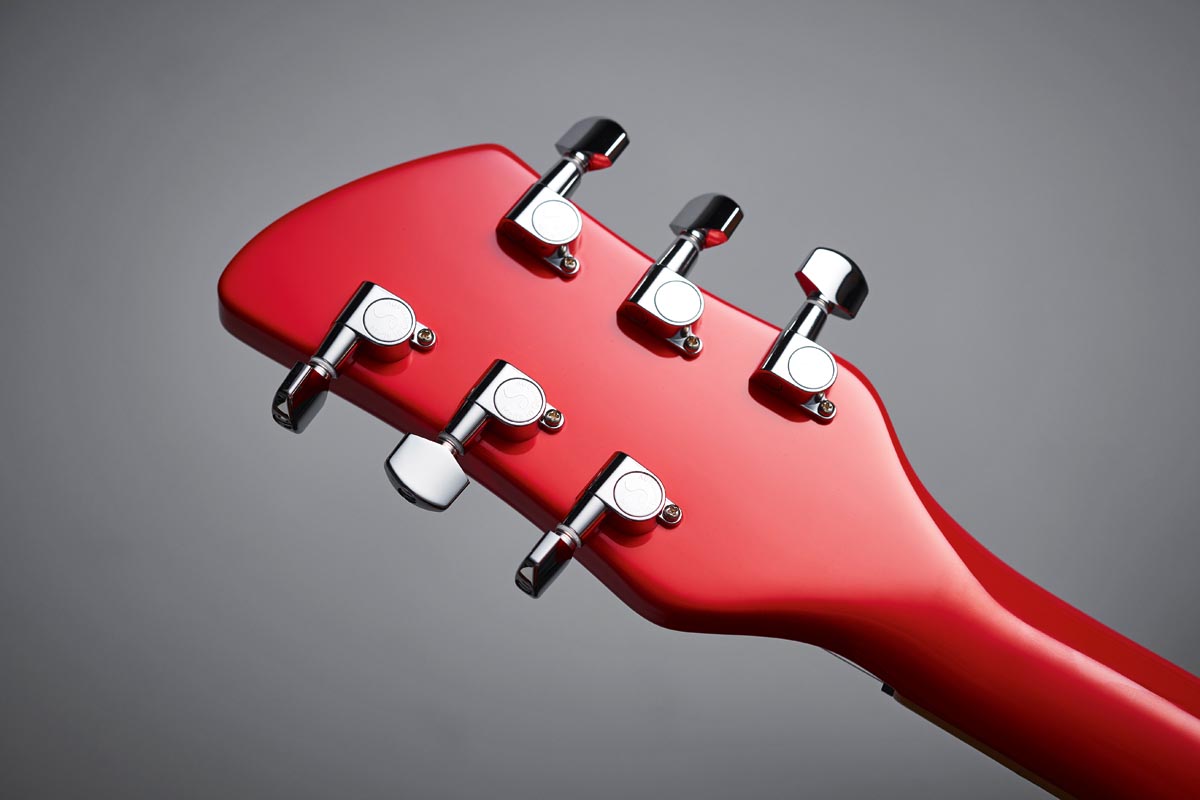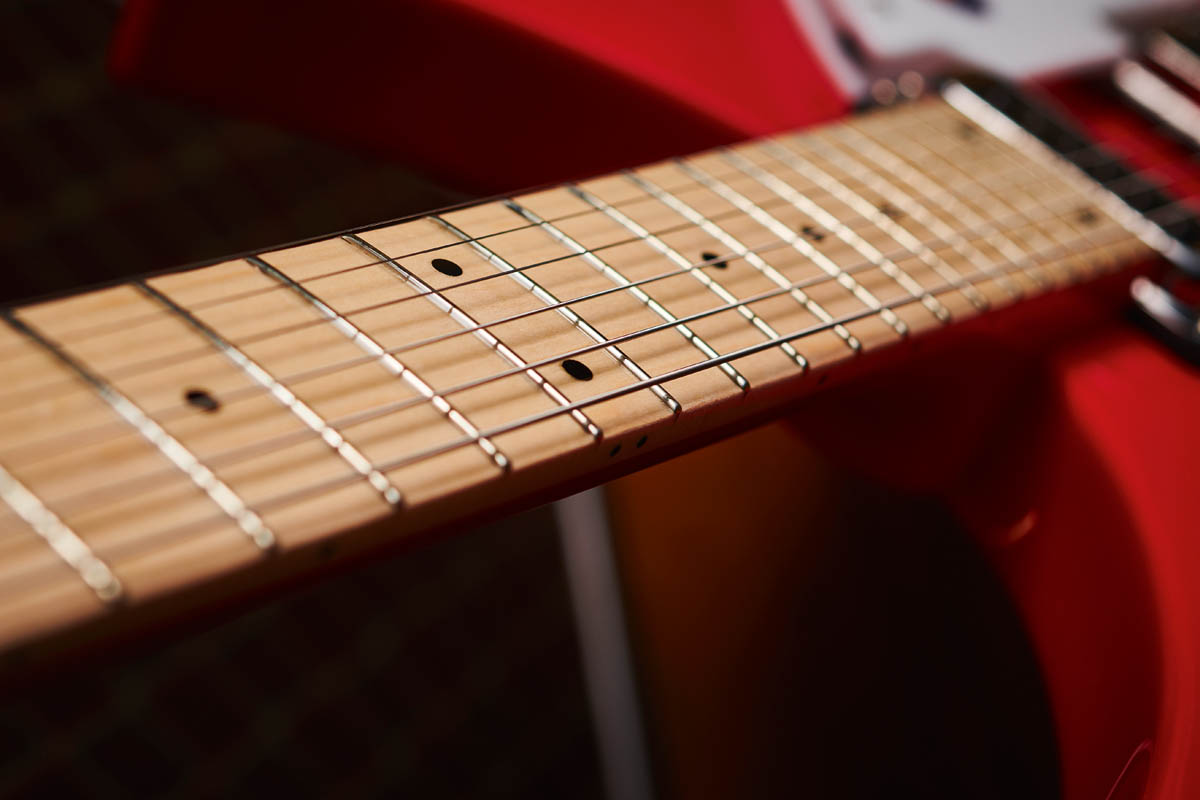Guitar World Verdict
You can't miss this limited-edition 330, not with a finish this bright, and not with this tone. Its open chime remains one of the classic sounds in electric guitar, and is deserving of rediscovery from the next generation of players looking to rewrite popular music history.
Pros
- +
Unrivalled chiming tones.
- +
Originality.
- +
Build quality.
- +
Image.
Cons
- -
Some will find it too quirky.
- -
Not a top choice for blues and rock.
You can trust Guitar World
It’s something of an occasion when Guitarist gets its hands on a new Rickenbacker guitar, so rare is it that they come along. And this one’s rarer than most, being a UK-only limited edition of only 25 guitars.
Imagine, then, the expectation on receiving a large cardboard box, opening the lightweight moulded case inside and finding this Pillar Box Red 330 model glowing back. It’s almost impossible to imagine how music from the latter part of the 20th century on would have sounded without Rickenbacker electric guitars and bass guitars.
Pack-leading artists such as The Beatles, The Who, The Byrds, Steppenwolf, Tom Petty, REM, The Jam, Motörhead, The Eagles, Yes, Genesis, Rush, The Smiths, U2 and more have all used Rickenbacker instruments to help them stand out from the crowd.
As the decades progressed, brands including Gibson and Fender, Gretsch and Epiphone expanded massively, with Asian production and models at every conceivable price point.

Yet Rickenbacker stuck resolutely to its traditional formula, making instruments in Santa Ana, California, in quantities that its production facilities and team of craftspeople allowed, and concentrating on the model range its customers expected to see. The 330 is one of Rickenbacker’s core models. Consistently its biggest seller, the 330 was an evolution of the Capri models from the late 50s.
It’s almost impossible to imagine how music from the latter part of the 20th century on would have sounded without Rickenbacker guitars and basses
Designed primarily by German luthier Roger Rossmeisl these were deep-bodied, double-bound instruments bearing this same ‘cresting wave’ cutaway design. In 1961 Rickenbacker reduced their body depth by an inch, from 2.5 inches (63.5mm) to 1.5 inches (38.1mm) making for a much more streamlined look and feel.
Other models in the 300 series included the 335 (with vibrato), the 340 (with an extra pickup), the 345 (three pickups and vibrato), the 360 (bound body and ‘shark fin’ inlays) and, of course, the 360/12 12-string as played by The Beatles and The Byrds. John Lennon famously used the smaller-bodied, short-scale 325 (vibrato version of the 320).
All the latest guitar news, interviews, lessons, reviews, deals and more, direct to your inbox!
To cloud the issue somewhat, UK importer Rose Morris not only altered one or two of the guitars’ features – including replacing the cat’s eye or ‘slash’ soundholes with standard f-holes – but also used its own numbering system, so the 325 became the 1996, the 330 the 1997, the 340 the 1998, and so on.

Construction of these guitars is complex but clever. A flat maple back is glued to a top and sides that have been pre-routed from a two-piece spread of maple to create acoustic cavities, pickup and control cut-outs and the neck’s mortise. Its tenon extends deep into the body, almost to the bridge, surrounded above and below by this sandwich and making repairs complicated and expensive, if not prohibitive.
Necks were generally maple-and-walnut laminates, with a thick chunk of unbound but lacquered African rosewood on top. The fingerboard’s 254mm (10-inch) radius initially featured 21 small frets, but this was increased to 24 in 1970. It was a radical if logical ploy, given that it laid out two complete octaves for the guitarist to explore.
Unusually, the neck also features twin truss rods in order to eliminate twisting – these are accessed (and can even be removed) via the large ‘shark fin’ plastic cover, inscribed with the legendary underlined Rickenbacker logo.
Our 330 Limited Edition is somewhat different to the norm, in that its neck material is stated as all maple, and the fingerboard a hefty lump of the same timber. As before it’s lacquered, remains unbound (as does the body), and retains the small position markers with double dots at the 12th and 24th frets. The Pillar Box Red finish is beautifully executed and buffed to a perfect gloss.

Early 330s featured Rickenbacker’s Toaster Top single-coil pickups while later versions, ours included, carry the more powerful but still jangly-toned Hi-Gain models. These occupy the same footprint, but feature black hex-key-adjustable polepieces in chrome surrounds, sit on full-sized sponge feet and are adjustable via crosshead screws at either end.
Other notable features include: the evocative ‘R’ tailpiece that resides in a sculpted recess with curved sides to mirror those of the cutaways; a five-control, two-tier plexiglass (acrylic) pickguard in white; a height- and intonation-adjustable bridge with removable chrome cover; and Schaller enclosed tuners and locking strap buttons. Of course, we can’t forget the black-edged cat’s eye soundhole so evocative of this model.
One element that often confuses guitarists is the five-control layout – and exactly what that smaller fifth knob does. Essentially, it’s a sort of ‘blend’ control, operating only on the naturally louder neck pickup to bring it in line with the bridge unit’s brighter but weaker tone.
Those who know Rickenbacker guitars well use this control to extract some of those warm but chiming rhythm and lead tones. The four larger knobs operate like a Gibson, albeit with the cluster rotated anti-clockwise by one turn so the two volume knobs are at the bottom and the tones at the top, the bridge pair to the right (as you play the guitar), and the rhythm pair to the left.

Feel & Sounds
Rickenbackers feel and play like no other guitars. Since the neck of the 330 joins the body at the 21st fret and the longer of the two cutaway horns protrudes to around the 13th, not only does it provide almost total fretboard access, it also means the guitar feels very normal on a strap.
There’s also very little fattening of the neck from the 1st to the 12th fret – it expands from 22mm to just 24mm. Given our preconceptions about what Rickies do, it might come as a surprise to learn that you can indeed play bluesy bends and vibrato on a 330, and of course there’s no reason why not.
The 254mm (10-inch) fingerboard radius with its fine vintage-style frets and the guitar’s 629mm (24.75inch) scale length should lend familiarity, yet there’s some indefinable element that makes it stand out as quite different. Nevertheless the medium C profile makes for a tireless playing experience, and at 3.6kg (8lbs) it’s a perfect weight on a strap and balances superbly.
The 330 offers a range of glorious chiming voices that run from Pete Townshend’s stuttering ejaculations to Paul Weller’s vicious attack; Peter Buck’s melodious arpeggios to Johnny Marr’s intricate lead-meets-rhythm lines. The Hi-Gain pickups are scatter-wound but in an identical, preordained way each time. They offer a clarity that’s all but impossible to extract from other guitars.

With both Strat and Tele to hand as comparators, each sounded more strident, a touch more powerful and ready to rock. The 330’s voice on the other hand is thinner, but never in a tinny, weedy way – the string separation is exceptional and the response immediate.
And even though these Hi-Gain pickups are more powerful than the old toaster top types, they sing in that incontrovertible Rickenbacker accent. If really pushed, we’d say it’s a bit like a slimmer-toned Gretsch, but nothing like the aforementioned Fenders. Although the neck pickup is warm there’s a shimmering character to it that’s exceptionally pleasing.
While the tone controls do what you’d expect, bringing in an almost jazzy or ‘woman’ tone element, a 330 is unlikely to be used that way; this is a tool for bright, articulate and musical tones. Flipping to the middle ‘both pickups on’ position, the blend control comes into play.
Balancing this against the even brighter (but never piercing) bridge pickup, all manner of glistening tones can be invoked – you could even leave the guitar set this way and use this control as a sort of tone ‘master’. But then you’d lose the spiteful edge that the bridge pickup delivers so brilliantly. Choices, choices.
Verdict
Once you’ve spent some time with a Rickenbacker you begin to understand why certain guitarists are drawn to their unique charms. While this very limited edition’s bright red finish won’t be to everyone’s taste, there’s always the company’s small but classic palette of colours to choose from (a standard 330 costs £500 less, too).
And yes, you can play lead on it – indeed, Townshend and Weller have both done it – but there cannot be a better guitar on which to strum rhythm and pick out arpeggios. The 330 is glorious in that regard because it offers a delightful set of sounds that are certain to rise above any mix.
Were you thinking about adding a new musical voice to your guitar arsenal, rather than opting for yet another of the usual suspects, we’d strongly suggest you get down to your local Rickenbacker dealer and try one
Image-wise, we can’t see many blues or rock guitarists going for one of these, so it’s likely to stay a staple of the 60s-inspired bands so associated with the model. However, were you thinking about adding a new musical voice to your guitar arsenal, rather than opting for yet another of the usual suspects, we’d strongly suggest you get down to your local Rickenbacker dealer (once it’s allowed, of course) and try one.
Plug into something like a Vox AC15 or Fender Blues Junior, make sure you set aside enough time to get used to how it plays and works, and odds on you’ll be pulled across to the dark side.
And in answer to our opening question ‘is the Rickenbacker 330 still relevant?’, you betcha! In fact, we reckon it might be time for the next Who, Jam or REM to come along and upset today’s all too predictable musical applecart. Kerchang!



Specifications
- PRICE: £2,879
- ORIGIN: USA
- TYPE: Double-cutaway semi-acoustic
- BODY: Solid maple top and sides routed for pickups, controls, etc, with glued-on maple back
- NECK: Maple, medium C profile, glued-in
- SCALE LENGTH: 629mm (24.75”)
- NUT/WIDTH: Black phenolic, 41.4mm
- FINGERBOARD: Thick maple, unbound with black dot inlays
- FRETS: 24, vintage-style small
- WEIGHT (kg/lb): 3.6/8
- HARDWARE: Chrome plated ‘R’ tailpiece, adjustable bridge with chrome cover, Schaller tuners and strap lock buttons
- STRING SPACING, BRIDGE: 51mm
- ELECTRICS: 2x Rickenbacker Hi-Gain pickups, 2x tones, 2x volumes, blend control operating on neck pickup only, 3-way pickup selector
- OPTIONS: None
- RANGE OPTIONS: Rosetti approached Rickenbacker to do a limited run of Pillar Box Red (PBR) guitars and basses with maple fretboards across 5 models. The others include the 360 PBR (25 only, £3,520); 4003 PBR bass (25 only, £3,265); 4003S PBR bass (25 only, £2,880); 4003S/5 PBR bass (10 only, £3,959). The standard 330 comes in at £2,398
- LEFT-HANDERS: Yes
- FINISHES: Pillar Box Red (this model only). Fire Glo, Jet Glo, Maple Glo, Midnight Blue (Standard 330)
- CONTACT: Rickenbacker
In the late '70s and early '80s Neville worked for Selmer/Norlin as one of Gibson's UK guitar repairers, before joining CBS/Fender in the same role. He then moved to the fledgling Guitarist magazine as staff writer, rising to editor in 1986. He remained editor for 14 years before launching and editing Guitar Techniques magazine. Although now semi-retired he still works for both magazines. Neville has been a member of Marty Wilde's 'Wildcats' since 1983, and recorded his own album, The Blues Headlines, in 2019.


